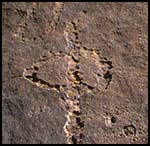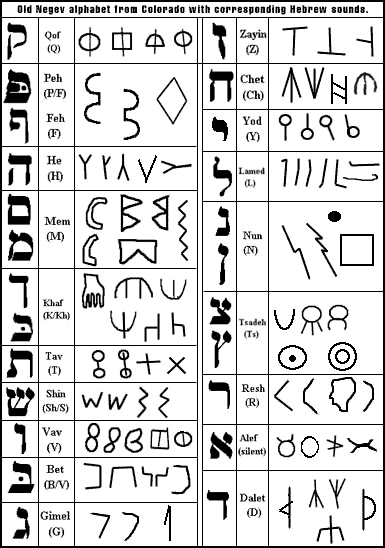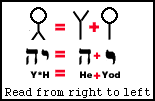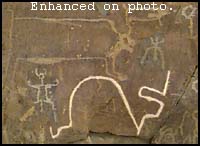Ancient History from the Scribes of Purgatory
The Purgatory River canyons were home to the Plains Indians, who found the area a good hunting ground. Thus, often the faint symbols of the ancient carvers have been covered with more recent art of the Ute and other tribes. It is only when one is trained to recognize the twenty two symbols of Old Negev, and the variants of each symbol to the region, that one can successfully identify a group or panel of the script.
The chart below shows some of the variants of the ancient alphabet as it was found in the Negev desert of Israel (known to have been made around 1500 BC) and in the Purgatory River canyons of Colorado. The corresponding Hebrew symbols are also shown.
You will note that each Old Negev symbol has a corresponding Hebrew character which represents a phonetic sound. A "Yod" will have the sound of a "Y," while a "He" will have the sound of an "H," and so on. As in Hebrew, the signs are often read from right to left, but not always. In ancient times there was really no convention for writing in a particular direction; however, the Purgatory scripts appear to use the right-to-left direction in most circumstances.
The method of translating the Purgatory River canyon symbols is fairly straight forward. Gary Vey has described many minor variants of the Colorado script from the Sinai version, but notes that these are only two letters of the alphabet. "In both cases," says Vey, "the people [in Colorado] reverted to a regional style based on the classic symbol but drawn their way." A group of Old Negev symbols is first identified and recorded. Any ligatures that appear are then broken down to their fundamental alphabetical elements and the Old Negev is then translated using old Hebrew sounds. The resulting language is then translated using an old Hebrew dialect. The following panel will illustrate this method.
Commentary by Gary Vey
 The petroglyphs of the Purgatory River (called "Picket Wire" River by the locals) are very old and worn by wind and the extreme temperatures of the region. The symbols are formed by pecking at the canyon wall with some sharp tool and the impressions, although once deep, are now very shallow and barely visible to the naked eye. [See close-up at right] In fact, the best way to view these petroglyphs is to approach the wall when the sun is at a right angle to the wall and will cast shadows in the tiny pits and grooves that are left in the stone.
The petroglyphs of the Purgatory River (called "Picket Wire" River by the locals) are very old and worn by wind and the extreme temperatures of the region. The symbols are formed by pecking at the canyon wall with some sharp tool and the impressions, although once deep, are now very shallow and barely visible to the naked eye. [See close-up at right] In fact, the best way to view these petroglyphs is to approach the wall when the sun is at a right angle to the wall and will cast shadows in the tiny pits and grooves that are left in the stone.
 Another interesting and important feature of this ancient writing system is the use of what are called ligatures. Since the symbols are often made from basic geometric shapes, they can be combined in visually interesting ways to form words. An example of a ligature is shown on the right. Notice how the ligature combines two basic symbols to spell the name of the deity, Yah. The vowel, in this case an "a" is omitted out of respect for the deity, whose name was never written on either continent out of respect for its sacred invocation. Ligatures sometimes can be designed to imitate the concept that they represent and their instant recognition helped facilitate the translation.
Another interesting and important feature of this ancient writing system is the use of what are called ligatures. Since the symbols are often made from basic geometric shapes, they can be combined in visually interesting ways to form words. An example of a ligature is shown on the right. Notice how the ligature combines two basic symbols to spell the name of the deity, Yah. The vowel, in this case an "a" is omitted out of respect for the deity, whose name was never written on either continent out of respect for its sacred invocation. Ligatures sometimes can be designed to imitate the concept that they represent and their instant recognition helped facilitate the translation.
 Dr. James Harris has noted that, in the Sinai desert, certain symbols are sometimes enlarged, rotated or inverted to indicate the end of a word or phrase. He also has recognized that many archaic symbols, called ideograms, appear to add meaning to the script. Ideograms were also used by the Plains Indians as a kind of shorthand - the most widely used was the outline of a reclining figure (below) with a pipe or protrusion extending from the mouth. Ideograms such as this were used in the same manner as one would use "once upon a time, long ago..." to introduce a story or legend.
Dr. James Harris has noted that, in the Sinai desert, certain symbols are sometimes enlarged, rotated or inverted to indicate the end of a word or phrase. He also has recognized that many archaic symbols, called ideograms, appear to add meaning to the script. Ideograms were also used by the Plains Indians as a kind of shorthand - the most widely used was the outline of a reclining figure (below) with a pipe or protrusion extending from the mouth. Ideograms such as this were used in the same manner as one would use "once upon a time, long ago..." to introduce a story or legend.![]() Viewzone || --NEXT-- || First Tongue
Viewzone || --NEXT-- || First Tongue